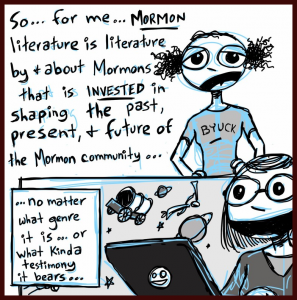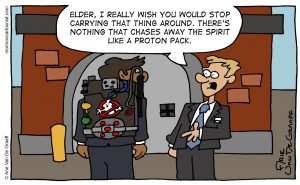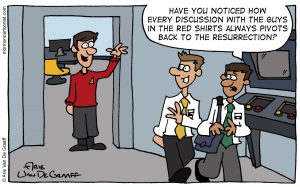Who among us has not wasted an hour or three at TVTropes.org, the highly addictive wiki-like format for tracing common themes and motifs in literary and dramatic works? C’mon, I see you sliding down in shame over there in that seat. What? Only me? Oh. Ahem. I mean, I’ve never done that, either. Right.

The point being that it’s tremendous fun both to categorize literary motifs and to see if other people’s examples match your own. Sadly, there is not, in fact, a version of TVTropes devoted to Mormon tropes in speculative fiction, though I did find this nice list over at Adherents.com, as well as this post at Juvenile Instructor. And this one by Eric James Stone here at Dawning.
So what would be some interesting categories of Mormon tropes in speculative fiction, either by Mormons or not? I’ll kick things off with a by-no-means-comprehensive list; feel free to add your own.
Throwaway Mormon References — I’m thinking here of things like Heinlein’s character in Double Star comparing his refusal to give specifics about his Martian adoption ceremony to why a Mormon wouldn’t share details of the temple ceremony with a close friend. (Details given in Eric James Stone’s post.)

Mormons as Badass — I hope this exists. I mean, it should. Arguably Heinlein’s mention of the Mormon Battalions as a repressed group joining the revolt in “If This Goes On” qualifies.
Persecuted/Isolationist Mormons — Certainly there in O.S. Card’s Folk of the Fringe stories, a lot of William Morris’s stories, etc.
Mormons Incognito — Arguably Zenna Henderon’s The People. Arguably Scott Card’s Book of Mormon in space The Call of Earth series. Battlestar Galactica. Maybe Heinlein’s Martian-inspired religion in Stranger in a Strange Land, if you squint really hard and ignore all the things that don’t fit. Others?

Transplanted Mormons — Mormons in space, Mormons in other places. Steve Peck’s “Let the Mountains Tremble, for Adoniha Has Fallen” springs to mind. Niven and Pournelle’s Mormon-settled planets in The Gripping Hand, sequel to The Mote in God’s Eye. Plus lots and lots of others.
Mormons Have Gotten Weirder — Most of the same references as the previous category, and more besides.

Mormons Have Gotten Blander — Actually, I’m not sure anyone has ever bothered to do this in speculative fiction. Because, what would be the point? People don’t read sf&f because they want blandness in their stories.
Laughably Inaccurate Mormon References — I know I’ve seen this, but no particularly egregious examples spring to mind at present.
Mormons as Ignorant/Intolerant — I’m sure this exists. No interest in straining my brain to come up with examples.
Thoughts? Additions? Amplifications?

I’d have to read it again for the details, but in Sherri Tepper’s novel Grass there’s some sort of ancestor devotion that was made to look squicky in the context of the novel. I suppose it was meant to ridicule vicarious work for the dead. When I mentioned that I enjoyed the novel to a friend of mine, she commented that she thought it was unusual that I would, given my religious background and the presence of this unsavory-seeming element of the story. I didn’t register it at the time as a dig at LDS doctrine or practice, since none of the other elements of the belief system seemed to line up. So maybe Mormons Incognito?
It’s always interesting when someone says something that’s intended as a criticism of Mormonism that is so far off-base you can’t actually be offended, only slightly puzzled.
I read Sheri Tepper (glommed her, actually, which I need to stop doing). Her agendas/biases/bitterness are very apparent in her work, so it wouldn’t surprise me, although I haven’t read Grass. Her agendas are diametrically opposed to mine, but I’m grateful to her for being so brazen about it because she gave me “permission,” if you will, to be brazen about mine. She’s a good storyteller and I figured, if her storytelling overcame my distaste for her message so much I enjoy her work, I should be able to do the same.
Thanks to Andrew for inserted graphics!
Transplanted Mormons is generally more Mormon Pioneers 2.0 in that there’s a sense that a large portion (if not all) of the community leaves the Intermountain West for a new frontier. That’s the situation for “Let the Mountains Tremble, for Adoniha Has Fallen”. I’m not sure on Niven/Pournelle’s series but it sounds like a similar thing. It’s true for two of the stories in my collection (although the migration stays planted on earth soil). Also of James S.A. Corey’s The Expanse series.
I think that’s important to point out because what makes it interesting to use Mormons in near(ish) future science fiction is the sense that because of their pioneer history and cohesive community, they may be more willing to make the kind of risks that come with colonization.
.
Mormons Underground: Mormons forced to hide from the world at large. The first story in Folk of the Fringe is like that and a couple in William’s collection as well.